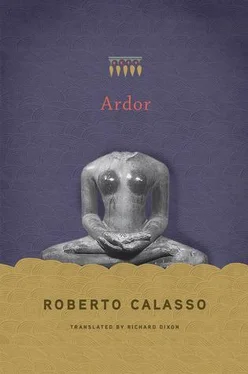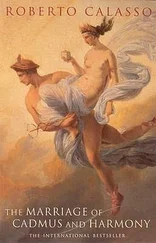The bride soon appears: “Sūryā’s fine dress was entirely embroidered with verses. The cushion was Intellect, the ointment was Gaze, the basket was Sky and Earth, on the day on which Sūryā went to her husband.” Beside her, two handsome identical young men: the Aśvins, her brothers and attendants. Sūryā moved forward: “Her chariot was Thought, and Sky was the canopy.” The chariot was drawn by the two months of summer. So summertime is auspicious for weddings. The effect of all that happened from the moment of Sūryā’s arrival has reverberated down to today, though the daughter of the Sun is long forgotten. And from that day the psyche of the bride has received its imprint. This must encourage the husband to be humble. Even though he will be the first to touch his bride’s body, he will be her fourth lover: “Soma had her first, the Gandharva had her second, her third husband was Agni, the fourth the son of man.” Though the twentieth century would include psychology among its discoveries, no inquiry into the psyche of the young girl, the kórē , has reached such precision. When she reaches her wedding, even if her body is intact, every young girl has a long love story behind her. Her first lover was Soma — or Hades — since he is the ruler, as white as moonlight or as black as the darkness of the Underworld. For he is absolute and final. But after Soma comes the Gandharva Viśvāvasu, the wicked genie, the mental image of eros that besieges the young girl in her solitude, her dreams, her games. He is stubborn and wily, he knows how to wheedle his way into women’s rooms and excite their fancy. Before the young girl can reach her marriage he has to be ritually driven out: “‘Leave here: this woman has a husband!’ thus I addressed Viśvāvasu with the homage of my songs. ‘Look for another young girl, who is still living with her parents: this is your fate: understand it.’” And if the Gandharva obstinately remains, he has to be told: “Leave here, Viśvāvasu! We implore you, paying homage to you, look for another, who may be lustful! Allow the bride to be united with her husband.”
The third lover is Agni. Why? Agni is everyone’s lover. Women, old and young, gathered around the fire and showed him the soles of their feet. From there the heat of the flames began to caress them, then climbed even farther, beneath their dresses, up to their thighs. If the Saptarṣis’ wives betrayed them with Agni, what resistance could there be from an ordinary girl who had not yet been touched — and who is now being caressed in a way that no one else would ever equal? The fourth is “the son of man.” His male arrogance is the most unfitting and unseemly. And yet, through the lengthy exercise of patience, with no claims to domination, he will have to find his way through the indelible memories of those lovers who have preceded him and whom he will try to emulate to succeed at last in being at least the fourth. And nothing will change when the young girl becomes a mother with many children. As the hymn says toward the end, invoking Indra: “Put inside her ten children, let her husband be the eleventh!”
XII. GODS WHO OFFER LIBATIONS

There is one gesture that inextricably unites the whole Indo-European world. It is the gesture of the libation. The pouring of a liquid into a fire that flares up, destroying a valuable or an ordinary substance in the flame. Libation is found back in the Minoan period, on the Hagia Triada sarcophagus. Homer’s characters often carry it out as a necessary preliminary to their exploits. Sacrifices performed with no libation are extremely rare. And even Olympian gods are depicted on many vases in the act of offering a libation. Erika Simon has studied them — and has asked the inevitable question: to whom are they offering the libation? And why do gods feel they have to do it, just as much as humans?
In India, libation is to be found everywhere. The brahmin has to perform it each morning before sunrise, and each evening before dusk. It is the simplest rite, the agnihotra , which lasts about a quarter of an hour. Hundreds of times a year, thousands and thousands of times throughout a lifetime. But in the description given in the Brāhmaṇas, even the smallest rite is broken down into almost a hundred acts. And the texts tirelessly reiterate that this rite encapsulates all the others, and they describe it as the arrowhead of all rites: “What the arrowhead is to the arrow, the agnihotra is to the other sacrifices. For where the arrowhead flies, there flies the whole arrow: and so all the works of his sacrifice are released, thanks to this agnihotra , from that death.”
It is not a social rite. The head of every family performs it alone. He needs no officiants, his consort is not present. Violence — which always leaves some mark, however much one tries to hide it — is absent here. But destruction is present, the irreversible yielding of something to an invisible presence. This action of abandoning something is called tyāga —and is often presented as the essence of sacrifice, of every sacrifice. Or otherwise: as its prerequisite. It is the gesture that indicates someone is approaching an invisible presence — showing submission or at least the willingness to give way. Marcel Granet, in Danses et légendes de la Chine ancienne , a work in which his genius shines, defined the virtue of jang , which is indispensable to the Son of Heaven, who wants to maintain his sovereignty, as a yielding in order to get , where it is essential that the gesture of yielding comes before everything else.
* * *
Libation: the act of pouring a liquid into the fire or onto the ground. Pure loss. Irreversibility. The gesture that most resembles the flow of time. The perfunctory Latins had only one word for it: libatio. The Greeks — three subtly different words: choḗ, spondḗ , and the verb leíbō. Spondḗ was the only way, in Greek, of saying “truce” or “peace treaty.” At the start of the Olympic games, heralds ran through Greece shouting: “Spondḗ! Spondḗ!” All fighting would then stop. The Vedic people used fourteen terms to describe a particular type of libation, graha , in a particular type of liturgy: the soma sacrifice. But only for the morning libations. Another five names were needed for those at midday. And five more for those in the evening. And yet they said there was no simpler, more straightforward act for showing the sacrificial attitude. “The murmured prayer is a covert form of sacrifice, the libation is an overt form,” we read in the Śatapatha Brāhmaṇa. For the prayer is murmured, while the act of pouring liquid cannot be hidden. Vedic men performed this act every morning, every evening. But so did the Greeks, according to Hesiod, who recommended the offering of libations “when you go to bed and when the sacred light returns.” The Vedic people built a huge edifice of other ritual acts around this single act — and catalogued them in vast commentaries. The Greeks included it in their daily lives and in their rituals without any theorizing. Homer very often speaks about libations, since they formed part of the events he was describing. Their significance was implicit. The libation, as well as being the simplest form of worship, was also the oldest, if we are to believe Ovid. Water had been poured before blood: “Hic qui nunc aperit percussi viscere tauri / in sacris nullum culter habebat opus.” “The knife that today opens up the entrails of the slaughtered bull / played no role in the sacrifices.” And, once again according to Ovid, the libation came from India. Dionysus, or Liber, had introduced it on his return from his eastern expeditions: “Ante tuos ortus arae sine honore fuerunt , / Liber, et in gelidis herba reperta focis.” “Before your birth the altars were without offerings, / O Liber, and grass grew on their cold hearths.” But Dionysus, “having conquered the Ganges and the whole Orient,” was said to have taught the offering of cinnamon, incense, and other libamina. From Liber also the name libatio. Through him the Vedic doctrine of sacrifice became meshed with that of the Romans.
Читать дальше













